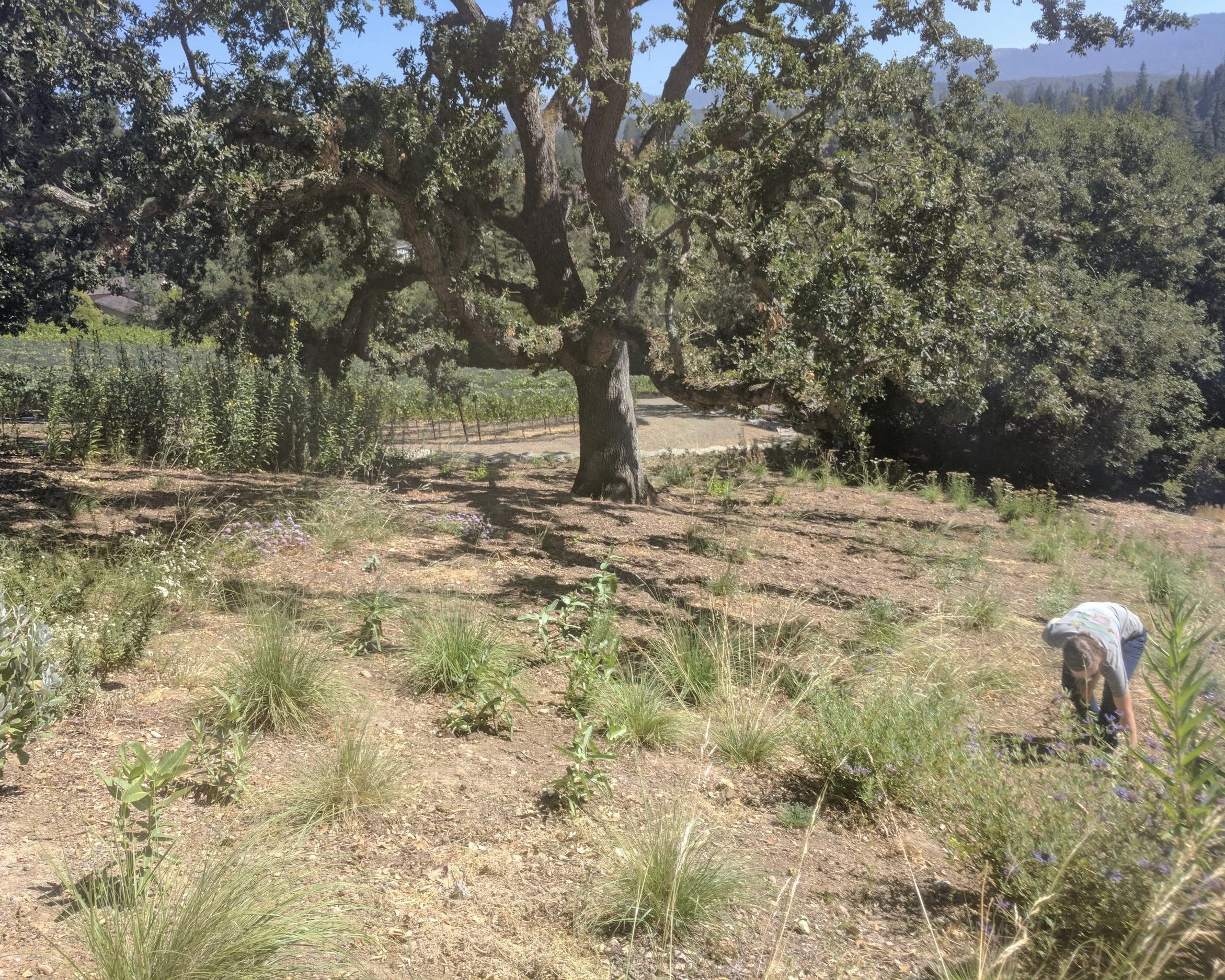RESIDENTIAL RECONCILIATION
ESTATE
Atherton, CA | 2017 - ONGOING (MAINTENANCE + MEADOW SEEDING)
Relying primarily on native plants to create a shared habitat for humans and wildlife, we transformed this previously sterile and overly formalized 9-acre residential landscape into a showpiece of reconciliation ecology, while simultaneously demonstrating that habitat restoration and elegant design need not be mutually exclusive. The design shuns archetypal residential landscape architecture projects by eschewing “blank slates” and new construction in favor of existing infrastructure and reduced carbon footprints. Plants instead define nooks and niches for people and create patches of wildness in this reimagining of the gardens of a Silicon Valley home.
Rather than simply focusing on “sustainability,” the client wanted us to develop a set of common denominators to unite aesthetics and application, translating lessons from ecology, habitat restoration, planting design, maintenance, and storytelling into the context of landscape architecture. The design focuses on reconciled systems that blend human comfort and aesthetic desires with ecological paradigms.
Using a hybrid of restoration, plant-insect ecology, and modern landscape design, our challenge is to recreate the robust habitats of primarily native plants that populations of native bees, birds, and other wildlife have co-evolved with, while simultaneously ensuring that the resulting gardens are stunning, delightful, and maintainable.
A California native grassland meadow planted with native grasses, perennials, and self-seeding annual and perennial wildflowers, functions as both a powerful carbon sink for the property and a low-burning fire break to help protect the residence. Native grasses form a matrix of foundation plants, ribbons of flowering perennials increase habitat value (while reducing weed competition), and grassland wildflowers attract pollinators and provide bursts of color. This particular habitat type is vital ecologically: less than 1% of native grasslands remain intact in California, and more than 90% of California’s rare and endangered animals need native grasslands to survive. Here, in stark contrast to the vast majority of suburban yards, a myriad of plant-insect interactions take place, providing the clients and their guests a rare opportunity to observe these coevolutionary relationships up close.
Having spent years maintaining the previous conventional plants, the clients’ two full-time gardeners initially did not support the new design scope. Before they would embrace native plants and their unique needs (leaving leaf litter under the oaks, pruning grasses every other year to protect habitat, etc.) we had to first gain their trust. Initially, this meant collaborating with them on plant selection, listening to their concerns, and learning from them as much as they learned from us. Subsequently, it evolved into a 40-page maintenance manual that included photos of every plant with explanations of how and when they should be maintained by season, focusing on general tasks, water needs, pruning, weeding, and transplanting. Although seemingly minor, this collaborative process reflects the crux of our design—without the implicit acquiescence and support of the gardeners, the project would have inevitably failed. With it, the garden continues to grow and thrive.
HIGHLIGHTED PLANTS
GRASSES:
Elymus condensatus (Giant Wildrye)
Festuca microstachys (Pacific Fescue)
Muhlenbergia rigens (Deergrass)
Stipa pulchra (Purple Needlegrass)
FORBS:
Achillea millefolium (Common Yarrow)
Asclepias fascicularis (Narrowleaf Milkweed)
Asclepias speciosa (Showy Milkweed)
Clarkia unguiculata (Elegant Clarkia)
Eschscholzia californica (California Poppy)
Lupinus densiflorus (Dense Flowered Platycarpos)
Lupinus succulentus (Succulent Lupine)
Trifolium bifidum (Pinole Clover)
meadow installation
SPRING 2020
MAY 2019
JANUARY 2019
AUGUST 2018
MAY 2018
JULY 2017
JANUARY 2017
EXISTING CONDITIONS
BEFORE
When Miridae started the project, lines of tea roses edged the pathways, English ivy hugged the hillside slopes, and sheared spherical boxwood hedges dominated the landscape. The 2-acre central gardens were irrigation-intensive (relying on overhead spray irrigation and the full allotment of city water allowed), and highly manicured.
ASLA SIERRA CHAPTER 2020 MERIT AWARD
This project received an ASLA Sierra Chapter 2020 Merit Award in the Single-Family Residential category. Click here to see the award on the ASLA California Sierra Chapter website.
Images by Saxon Holt and Miridae

























